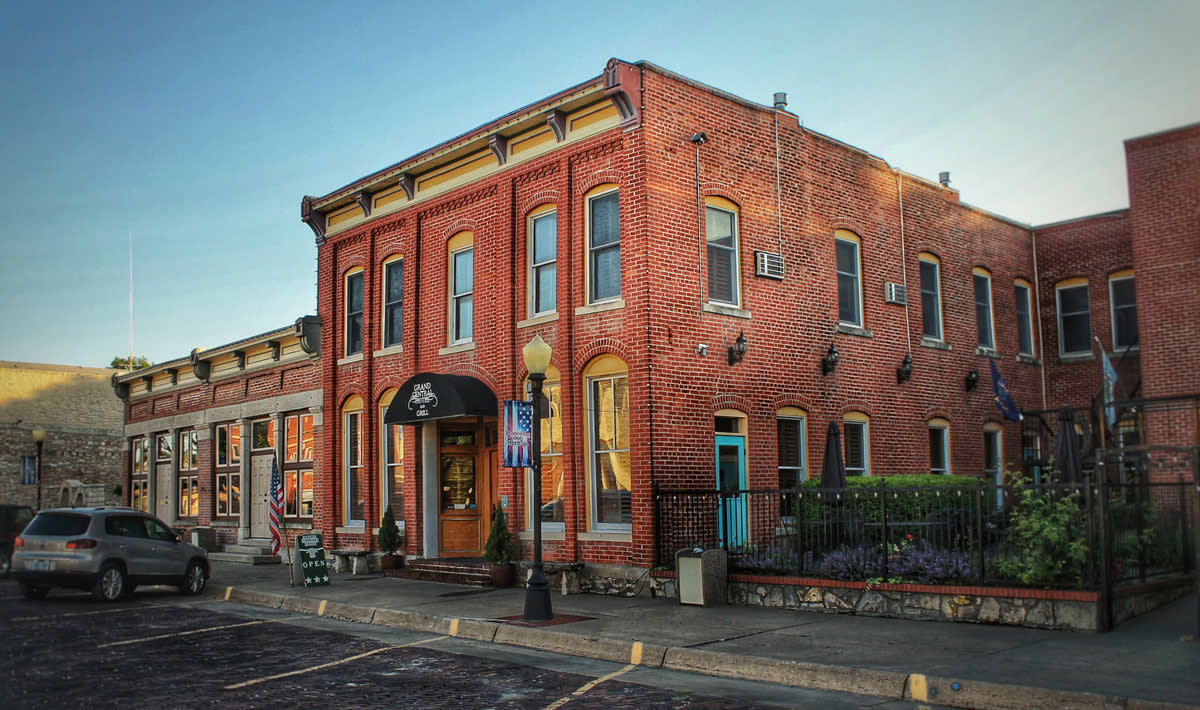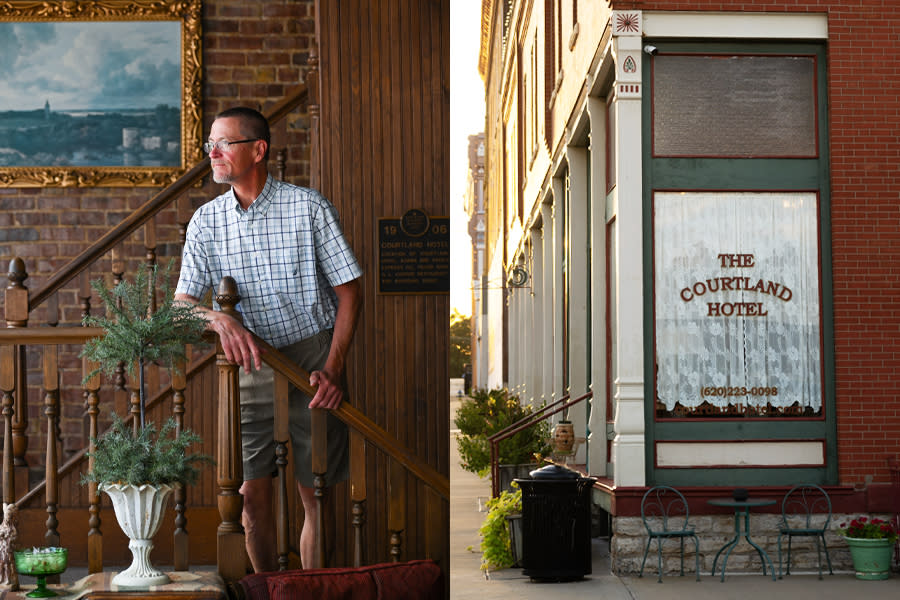
Grand old lodgings in Kansas offer peek into the past
Historic hotels offer more than a good night’s sleep. Constructed more than a century ago, grand old lodgings in Kansas have storied pasts that include movie appearances, private poker games, nearby bank robberies, and underground tunnels.
If only the three-story limestone walls of the Midland Railroad Hotel could talk. They would reveal how the fire started that gutted the hotel just three years after it opened, who had the idea of raising chickens on the third floor, and what led to the hotel’s role in the 1973 film Paper Moon.
Like many other historic lodgings, the Courtland Hotel in Fort Scott and the Midland Railroad Hotel in Wilson embrace their heritage, offering guests a peek into times past while catering to the needs of today’s travelers. And like all buildings more than a century old, these hotels have plenty of stories to tell.
Called the Power Hotel when it was built in 1899, the Midland Railroad Hotel was considered among the premier lodging establishments in the Midwest with 28 elegant rooms lit by acetylene gas, the newest method at the time. Because of the depot’s location across the street, the rebuilt hotel arose from the ashes of the fire in 1902 to become a popular stop for those traveling between Kansas City and Denver on the Union Pacific Railroad. Traveling salesmen so often departed the train to display their wares in the hotel’s basement that it became known as the Sample Room.
Years later, chickens were raised on the third floor out of necessity, according to the hotel’s owner Melinda Merrill.
“They did it during the Depression because, number one, the chickens didn’t get stolen, and number two, there was also water stored up there,” Merrill says. The birds were served to guests for dinner as a way to make ends meet in the 1930s. Ironically, an 80-ounce steak brought in new customers during recessions in the early 1980s. “It was an advertising ploy; you got the steak free if you ate the whole thing, otherwise you had to pay for it.”
Featuring stained glass windows in the parlor and the original staircase and woodwork, the hotel was chosen as a filming location for the 1973 movie Paper Moon; photographs of the Hollywood stars that roamed its halls remain on display.
But the hotel isn’t stuck in the past; it simply blends the ambiance of a bygone era with all the amenities today’s travelers require. Merrill says a renovation in 2001 added a bathroom to every room and central air and heat. As technology evolved, Wi-Fi and satellite television were installed.
The hotel serves a continental breakfast of kolaches (a Czech pastry), quick breads and biscuits, all made from scratch and paired with sausage purchased locally. The Sample Room Tavern restaurant is open six days a week for dinner and includes a top-shelf whiskey bar. The hand-cut steaks are popular, as is the chicken fried steak served with mashed potatoes and gravy.
“It really helps for the modern traveler to have some place in small towns to eat,” Merrill says. Despite a population of just 863 residents, Wilson is no sleepy town. Deemed the Czech Capital of Kansas, the popular tourist destination is home to the World’s Largest Hand-Painted Czech Egg, is in proximity to Wilson Lake, and is located along the Post Rock Scenic Byway.

The hotel recently added a 1907 barn to the premises as a social event center. The Barn Kansas Libations Club and Social Room, with its original stalls intact amidst farm-chic decor, is a place for groups to share stories and create history while feasting on barbeque and sampling beers and whiskeys.
In Fort Scott, the walls of the Courtland Hotel and Spa owned by Frank and Cheryl Adamson also could tell many stories, including one about poker games in the basement where a knock at the locked door only was answered if the man knocking was known to have enough cash on hand to play, according to Frank Adamson.
The Courtland opened in the early 1900s to meet the arrival of increased railroad traffic.
“The first 50 to 60 years of this business, the lodging was essentially for men only,” Frank says, adding the hotel mostly housed railroad engineers and brakemen who brought the trains into town, spent the night, and reported back to work to replace the crews coming in on returning trains the next day. “The guys staying in these hotels were the same guys all the time.”
The building was originally constructed with six storefronts on the first floor to accommodate retail and wholesale businesses; the upper level had lodging rooms and a tailor shop. When the number of trains declined, the hotel eventually was used as a dormitory for a flight school before slipping into darkness.
Seeing its potential, the Adamsons awakened the building from its sleep. Today, its exterior remains as it looked in 1906, and the lobby inside retains its 14-foot tin ceilings and other architectural features. Guests and local residents enjoy the main level’s 2,500-square-foot, full-service day spa the couple added in a way that maintains the unique building’s historical significance.
An original open staircase leads to the 14 guest rooms, each uniquely decorated to reflect the hotel’s early years.
“We try to keep it as historic as possible but yet modern,” Frank says. “We keep everything that hints of the early 1900s, but we have rooms in which we have a king-size bed—and in 1906 there was no such thing as a king-size bed.”
The hotel departs from past services by offering all the amenities travelers now require.
“You are looking at fiber optic, gigabyte download, gigabyte upload internet in this building now,” he says. “When this hotel was built, the streets were dirt. It’s something to think about.”
The red brick hotel is located in the center of Fort Scott’s downtown historic district named to The National Register of Historic Places, and is within walking distance of the Fort Scott National Historic Site, seven restaurants, shopping, and entertainment venues.
“The significance of these old historic buildings is that they are a piece of Americana you cannot get back if you destroy it,” Frank says. “There are a lot of stories, a lot of history that could be lost by not maintaining and preserving buildings like this. In the last 19 years of having this building, I have truly, truly became wealthy within from learning the history around in the area and being able to share that with people. There’s something about a hotel that was built 150 years ago that you can’t recreate, and if it is torn down, it’s gone forever; the connection to our history and the connection to our past, that story dies.”
More Historic Hotels around the State
ELDRIDGE HOTEL
Lawrence
In 1932, Bonnie and Clyde gang members stayed at the Eldridge Hotel in Lawrence to observe activity at the bank across the street in preparation for a heist. The building was the fourth and final hotel constructed on the site in what is now downtown Lawrence. In 1856, settlers sent by the New England Emigrant Aid Society to ensure Kansas enter the Union as a free state quickly built the Free State Hotel in this location to use as temporary housing while they built their permanent homes. That same year, the hotel was burned by proslavery forces; although quickly rebuilt, it then was destroyed in Quantrill’s Raid on Lawrence in 1863. Again, it was rebuilt in 1866 as one of the finest hotels west of the Mississippi River. By 1925, the hotel had deteriorated and was rebuilt and renamed the Eldridge Hotel. A major renovation in 2005 returned it to its former grandeur. The Eldridge currently offers 48 suites, a full-service restaurant, lounge, and banquet space.
GRAND CENTRAL HOTEL AND GRILL
Cottonwood Falls
Each door to the 10 oversized rooms in The Grand Central Hotel is adorned with a cowboy-spur knocker and emblazoned with the cattle brand of a local historic ranch after which the room is named. Touting itself as small and elegant with a western flair, the Cottonwood Falls hotel was constructed in 1884 and provided lodging under several different names until it was renovated in 1995 and reopened as The Grand Central Hotel and Grill. Each bedroom window offers a unique view, and both the Turkey Track and the Crocker Ranch rooms include paver-bricked patios for private dining. While seated in the dining room, which retains original red brick walls and stockyard brick flooring, customers savor the restaurant’s specialty, premium steaks, with a cocktail or glass of wine.
WEAVER HOTEL
Waterville
Bullets flying during a nearby bank robbery in December 1910 created holes that still can be seen in some of the windows in The Weaver Hotel. William E. Weaver built the trackside hotel in 1906 for his parents, and the guest rooms on the upper levels and restaurant on the ground floor became a hub for passengers waiting for their trains and for those attending performances at the Opera House across the street. The three-story building in Waterville always operated as a place of lodging until it closed; several years later, the Waterville Preservation Society reopened the important piece of the community’s history after giving the structure a facelift. The hotel’s architecture features curved walls and windows popular during the early 1900s. Today there are 10 rooms available, two of which are large suites.
HISTORIC ELGIN HOTEL
Marion
Unable to secure outside investors for a hotel to stimulate the local economy and attract visitors to the community of Marion, the local real estate firm of Case and Billings persuaded the townspeople to buy stock to fund the construction of the Elgin Hotel, which opened in 1886. The limestone hotel has lived many lives; it closed in 1967 and avoided the wrecking ball by one week to become an apartment building. In 2009, it underwent a restoration to become a bed and breakfast, and it was renovated again in 2016 to become today’s boutique hotel. Each of the 12 unique suites is named for a notable Kansas figure or location, such as the Eisenhower, the Amelia Earhart, and the Flint Hills. Guests have access to five living rooms, veranda, fitness center, game lounge, restaurant and bar. Live events include craft beer and wine tastings, murder mystery dinners, and special occasions such as weddings, elopements, and business retreats.
THE HISTORIC WOLF HOTEL
Ellinwood
Built in 1894 by John Wolf as an addition to the Delmonico Hotel, the structure included a new lobby, intricate tile work in the Bank of Ellinwood on the main level, and underground stores. Restored in 2013 as the Historic Wolf Hotel and Event Center, it features Victorian furnishings. Its Underground Saloon becomes a speakeasy featuring Prohibition-era drinks on Friday and Saturday nights. Tours of the underground tunnels are available by advance reservations. Events such as murder mysteries and comedy shows are announced on their website.




